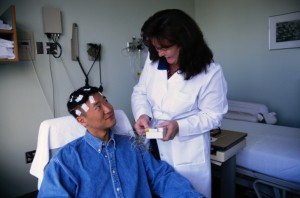Frequent seizures? What you should know about epilepsy
 One moment you can be completely fine, carrying on with your day, and in a split second it can all change. You convulse, you lose control and you begin to act quite differently.
One moment you can be completely fine, carrying on with your day, and in a split second it can all change. You convulse, you lose control and you begin to act quite differently.
If this scenario only occurred to you once, you’ve likely experienced a seizure. But if it becomes a reoccurring event, you could have epilepsy.
What is epilepsy?
It can be frightening for you and those around you when you begin shaking and losing consciousness – and that is what makes epilepsy so serious.
 Epilepsy is neurological disorder which means it affects the nervous system. Seizures happen because there is a disruption in the neurons when attempting to communicate. The Mayo Clinic reports that one in every 26 Americans will suffer from a seizure disorder making epilepsy the fourth most common neurological disorder.
Epilepsy is neurological disorder which means it affects the nervous system. Seizures happen because there is a disruption in the neurons when attempting to communicate. The Mayo Clinic reports that one in every 26 Americans will suffer from a seizure disorder making epilepsy the fourth most common neurological disorder.
Epilepsy can lead to other health concerns and can involve different types of seizures. Epilepsy is chronic and the longer the seizures last, the more damage they can cause.
As we mentioned, epilepsy is scary and it can impact your sense of safety. Because the seizures are random, they can occur while driving, crossing the street or anytime where further injury may result. Proper epilepsy management and treatment is essential to live safe and happy.
Causes of epilepsy
In order to receive a diagnosis of epilepsy, an individual must experience at least two unprovoked seizures. These seizures cannot be a result of an underlying medical condition or withdrawal from alcohol or drugs.
A potential cause of epilepsy can be the result of a brain injury but generally causes of epilepsy are unknown. What we do know, though, are some potential causes of the seizures themselves which include:
- Genetics
- Changes in the brain
- Autism
- Infections of the brain
- Head injuries
- Strokes or tumors
- Illnesses which affect the brain like Alzheimer’s disease.
The Epilepsy Foundation reports that six out of 10 seizures are idiopathic which means the cause is unknown. This number is quite high and that is what makes it so difficult to pinpoint an exact cause of epilepsy. Although it may be frustrating to not know the cause of epilepsy, treatment can still be carried out as long as you haven’t experienced stroke or a detected tumor.
Signs and symptoms of epilepsy
 There are two forms of seizures linked with epilepsy: Partial and generalized. A partial seizure mainly affects a small part of the brain and a generalized seizure can affect the majority or all of the brain.
There are two forms of seizures linked with epilepsy: Partial and generalized. A partial seizure mainly affects a small part of the brain and a generalized seizure can affect the majority or all of the brain.
These are the signs and symptoms of a partial seizure:
- Feeling “strange” or feelings that are indescribable
- A feeling in your stomach similar to that of riding a roller coaster
- Déjà vu
- Experiencing unusual tastes or smells
- Tingling sensation in limbs
- Intense emotions, like fear or joy
- Stiffness or twitching
- Smacking of lips
- Rubbing of hands
- Random noises
- Movement of arms
- Changes in posture
- Chewing or swallowing
- Not being responsive
- Loss of memory of the event.
There are six types of generalized seizures: Absences, myoclonic, clonic, atonic, tonic and tonic-clonic. The signs and symptoms of each involve convulsions, muscles relaxing or stiffening, jerking and twitching, and losing awareness of surroundings.
Types of epilepsy
There are 18 different types of epilepsy. Below is each type along with their description or common characteristics.
As you can see, many forms of epilepsy occur as young as at birth, but many of them can follow a person right into adulthood. Because so many types of epilepsy don’t have an exact cause, it is hard to suggest preventative measures. The best way to live with epilepsy is with supervised medical intervention – with medications, surgery or avoiding potential triggers.
It may seem stressful to have epilepsy, but with proper care and management you can still enjoy a fulfilling life.
-
The 300 movie workout routine
Ever since the movie “300” arrived on the scene and the ri
-
Weight Loss Diet Plan - What Really Works
Get the right diet plan and you are on y
-
Lose Stubborn Belly Fat - Take the Steps to a Happier You
It’s no mystery to anyone these days as to how to properly lo
-
Weight Loss: Setting Reasonable Long Term Goals
We see a lot of people struggling with weight issues and their body i
-
Tummy Tuck Scars Are Simply A Trivial Drawback After Cosmetic surgery – Don’t Allow It To Dispirit You
Once you provide yourself a good amount of time to mend from the cosme
-
Ways To Enable An individual To Reduce Weight Inside A Seven Day Period
You are aware of this idea: you have a s
- DON'T MISS
- Five Important Fat Loss Factors
- 3 Ways Your Hormones Are Sabotaging Your Slim-Down Plan
- Weight Loss Surgery Boosts Risk For Substance Abuse
- Eat Wholesome Foods and Lose Weight Fast Naturally - Ways of Staying Slender Forever
- Lose the Baby Weight with Healthy Food and Exercise
- Rapid Weight Loss Tips Techniques And Strategies
- What To Consider In Choosing The Right Weight Loss Techniques
- Good Nutrition Can Lead to Desired Weight Loss
- Your Ultimate Goal For Weight Loss: Achieve It With These Tips
- Do I Need To Exercise To Lose Weight?




